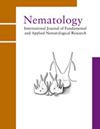Host-parasite relationship between Aphelenchoides besseyi and soybean
IF 1.2
4区 生物学
Q2 ZOOLOGY
引用次数: 1
Abstract
Aphelenchoides besseyi is a concern to Brazilian agriculture, since the losses caused by the green stem and foliar retention syndrome in soybean, especially in hot and humid climates, could reach high levels. However, limited information is available regarding the host-parasite relationship. The objective of this study was to evaluate the capacity of A. besseyi to penetrate soybean roots and its movement in soybean tissues until reaching the top parts. Plants inoculated with 1000 A. besseyi were evaluated for root penetration from 1-28 days after inoculation (DAI), and post-penetration and movement inside tissues by staining them with acid fuchsin. Plant development, chronology of the symptoms and the number of pods were also evaluated at 60 DAI. Aphelenchoides besseyi was found in the cortex and xylem vessels of roots from 1 DAI. During the experimental period, the number of nematodes from roots to shoots increased more than 123, 330 and 430%, respectively, for roots, stems + petioles + inflorescences, and leaves, demonstrating the ascendent movement of A. besseyi. Necrotic lesions in young leaves and apical tissues were observed from 8 DAI; the typical symptom of ‘amachamiento’ was observed from 10 DAI, with enlargement of nodes and lesions in inflorescences and, at 30 DAI, stunted plants were detected. At 60 DAI, inoculated plants had lower numbers of pods and exhibited severe symptoms including abortion of flowers and tissue splitting and cortical lesions in a few pods and roots. These observations emphasise the importance of A. besseyi for Brazilian soybean production.贝氏圆蚧与大豆的寄主关系
巴西黄豆(Aphelenchoides besseyi)是巴西农业关注的一个问题,因为大豆的绿茎叶滞留综合征造成的损失,特别是在炎热潮湿的气候下,可能会达到很高的水平。然而,关于宿主-寄生虫关系的信息有限。本研究的目的是评价贝赛木渗透大豆根系的能力及其在大豆组织中的运动,直至到达大豆根部。用酸性品红染色法对接种1000株贝赛依的植株在接种后1 ~ 28天根系的穿透性、穿透后根系在组织内的运动进行评价。在60 DAI时还评估了植物发育、症状的年代学和豆荚的数量。在1 DAI的根的皮层和木质部导管中发现了贝塞阿芬。在试验期内,根、茎+叶柄+花序和叶的线虫数量分别增加了123、330和430%以上,显示了贝塞木的优势运动。从8 DAI开始观察幼叶和根尖组织的坏死病变;从10 DAI观察到典型的' amachamiento '症状,伴有淋巴结肿大和花序病变,在30 DAI检测到发育不良的植株。在60 DAI时,接种植株的荚果数量减少,并表现出严重的症状,包括花流产、组织分裂和少数荚果和根的皮质损伤。这些观察结果强调了贝塞伊芽孢杆菌对巴西大豆生产的重要性。
本文章由计算机程序翻译,如有差异,请以英文原文为准。
求助全文
约1分钟内获得全文
求助全文
来源期刊

Nematology
生物-动物学
CiteScore
2.60
自引率
33.30%
发文量
67
审稿时长
3 months
期刊介绍:
Nematology is an international journal for the publication of all aspects of nematological research (with the exception of vertebrate parasitology), from molecular biology to field studies. Papers on nematode parasites of arthropods, and on soil free-living nematodes, and on interactions of these and other organisms, are particularly welcome. Research on fresh water and marine nematodes is also considered when the observations are of more general interest.
Nematology publishes full research papers, short communications, Forum articles (which permit an author to express a view on current or fundamental subjects), perspectives on nematology, and reviews of books and other media.
 求助内容:
求助内容: 应助结果提醒方式:
应助结果提醒方式:


